
Claremont Colleges
Scholarship @ Claremont
#+',.5#/#/ 01"#+0!&,)./&'-
Going Undra!ed: Survival of Undra!ed Free
Agents and Seventh Round Dra! Picks in the NFL
Trey Smith
Claremont McKenna College
5'/-#+!!#//#+',.5#/'/'/ .,1%&00,3,1 3!&,)./&'-).#*,+00&/ ##+!!#-0#"$,.'+!)1/',+'+0&'/!,))#!0',+ 3+10&,.'4#"
"*'+'/0.0,.,.*,.#'+$,.*0',+-)#/#!,+0!0 /!&,)./&'-!1!!).#*,+0#"1
#!,**#+"#"'00',+
*'0&.#3,'+%+".6#"1.2'2),$+".6#".##%#+0/+"#2#+0&,1+".6'!(/'+0&# CMC Senior
eses
&7-/!&,)./&'-!).#*,+0#"1!*!0&#/#/
Claremont McKenna College
Going Undrafted: Survival of Undrafted Free Agents and Seventh Round
Draft Picks in the NFL
submitted to
Professor Eric Helland
by
Trey Smith
for
Senior Thesis
Fall 2017
December 4, 2017
1
Acknowledgements
First off, I would like to thank Professor Eric Helland for all the support and
guidance he gave me throughout the writing of this paper. I would also like to thank all
the professors, coaches, and mentors that have sparked my interest in this subject matter
and provided me with valuable knowledge to write this paper. Secondly, I would like to
thank my friends who supported me through endless constructive discussions of our
topics and deep care of each other’s lives. The time spent here with you all will be
memories I think of for the rest of my life. Finally, I would like to thank my family.
Connor, Sean, and Chris, thank you for the endless support and encouragement you have
given me. Dad, thank you for all the wisdom about school and life in general. Most of all,
I would like to thank my mother who provided me the unconditional love that can’t be
found anywhere else.
2
Abstract
Over the years there have been a lot of undrafted free agents that have had
successful careers in the NFL. The monopsony structure for rookies entering the NFL and
the fact that undrafted free agents get to pick what team they play for suggests that there
is an advantage in not getting picked in the draft. To explore this possibility, this paper
compares the probabilities of remaining in the NFL for undrafted free agents and seventh
round draft picks through logit regressions and survival analysis. In doing so, this paper
describes the processes the NFL takes in order to find the most elite talent and how they
distribute the talent throughout the whole league. The results find that undrafted free
agents have a higher probability of exiting at the beginning of a career when compared
with seventh round draft picks, but there is evidence that those probabilities start to
converge later in careers. Additionally, there is evidence that there are NFL teams and
position groups that do better and worse in retaining undrafted free agents, suggesting
that there is a way to take advantage in going undrafted.
3
Table of Contents
Section I: Introduction…………………………………………………………………….4
Section II: Background……………………………………………………………………7
A. NFL Recruitment………………………………………………………………….7
B. Monopsony Exploitation in the NFL……………………………………………...9
C. The NFL Draft…………………………………………………………………...11
D. Making it Undrafted……………………………………………………………...13
Section III: Data………………………………………………………………………….20
Section IV: Model and Specifications…………………………………………………...22
Section V: Regression Results…………………………………………………………...25
Section VI: Conclusion…………………………………………………………………..28
Appendix…..……………………………………………………………………………..31
Bibliography………………………………………………………………...………...…45

4
Section I: Introduction
It is safe to assume that the most elite football players in the world end up in the
National Football League (NFL) without any competition from other leagues. Knowing
that, the NFL finds itself in an interesting labor market called a monopsony, where they
face an upward sloping supply curve, so when they bring another player into the league
they have to increase the salaries for every player causing a constant inflow of the best
available players.
1
The NFL also has practices revenue sharing, where all teams share the
revenue from gate sales, television contracts, and general merchandise sales.
2
This nature
of the NFL has serious implications in that new players are distributed throughout the
thirty two teams in the NFL through a draft. Throughout players’ careers through high
school and college, team owners consistently gather information on players that will
provide the most profit for their team, while players wait to see if they will get drafted by
a team in the one of the yearly NFL drafts. Over the years, there has been a lot of players
in the NFL that were not drafted and end up being one of the league’s biggest stars, while
you might never hear anything about players who were picked in the late rounds of the
NFL draft. There doesn’t seem to be much difference between seventh round draft picks
and undrafted free agents in terms of salary and coaching attention when comparing them
against early round draft picks. Seventh round draft picks and undrafted free agents make
around $450,000,
3
while first round draft picks expected salary is to be around $4
1
Boal, William M., and Michael R Ransom. "Monopsony in the Labor Market." Journal of
Economic Literature 35, no. 1 (1997): 86-112. http://www.jstor.org/stable/2729694
2
Ibid.
3
Ginnitti, Michael. "NFL Minimum Salaries for 2017." The Daily Spot. January 28, 2017.
Accessed November 14, 2017. https://www.spotrac.com/blog/nfl-minimum-salaries-for-2017/.

5
million.
4
With that kind of investment going into players, franchises are expected to put a
lot more of their time and effort into these early round draft picks because general
managers want their predictions on these players to pan out. This leads to coaches putting
first round draft picks in positions where they can only prove that they can’t play, and
leaving late round draft picks and undrafted free agents in positions where they have to
prove that they can play.
5
Other than the hit on undrafted free agents’ egos for not being
picked by a team, there are very few differences between seventh round draft picks and
undrafted free agents. Both players will have to compete for a spot on the team during the
preseason and continue to perform once they do make a team. An advantage that an
undrafted free agent has, although, is that they have the opportunity to pick what team
they end up on by calling coaches and joining preseason workouts. His status as an
undrafted free agent means he is free to leave and join different teams at his own will and
put him in a more competitive labor market between teams, whereas drafted players are
stuck with the team they were picked by unless they are released. Ray Polk, a Colorado
safety attempting to make a NFL team, admitted that “if you get drafted, you get to say
that you got drafted… but you go free agent, you get to choose a different fit or different
scenarios that you can put yourself into”
6
and even Andy Reid, Kansas City Chiefs head
coach, acknowledged that “as far as making [a] team, maybe it’s not [not better to be
drafted]... if you look at the stats, there are a whole lot of undrafted free agents playing in
the NFL right now… you can choose where you go, where you have a chance to make
4
Riddle, Ryan. "The Hidden Advantage of Being a High NFL Draft Pick." Bleacher Report.
April 12, 2017. Accessed November 14, 2017.
5
Ibid.
6
Stapleton, Arnie. "It's quite frequently better to go undrafted in the NFL." DeseretNews.com.
April 23, 2013. Accessed November 14, 2017.

6
the team.”
7
As a player that might be drafted in the late rounds of the NFL draft, it is
possible that the route of going undrafted and picking the team you will play with will
lead you to a longer career in the NFL .
Starting with first round drafts picks, the difference in skill between the next
round gets smaller and smaller up until the seventh round where the picks can be a toss-
up due to a lack of information that teams might have on players of that skill level,
leaving team owners to make their own opinions on the player’s ability and leaving a lot
of players to not get drafted. This leads us to think that these players can perform just as
well, if not better, as late round draft picks, but what makes that decision described in the
last paragraph so difficult is the lack of actual empirical evidence that can show that
undrafted free agents will do better than late round draft picks. The only criteria that
players can base their decision off of is the experiences of other players that have done it,
and while it might be helpful to see what other players have done to accomplish their
dreams of playing in the NFL, it is important to see the numerical evidence for it or
against it. Also, while there are a lot big names that went undrafted, there are a lot more
undrafted free agents that you haven't heard about that failed to have a NFL career. In this
paper, I will compare the probability of exiting the NFL as an undrafted free agent to the
probability of seventh round draft picks exiting through a logit regression model and
survival analysis to see if undrafted agents actually have a better chance to have a longer
career in the NFL.
This paper proceeds as follows. In section II, I will provide some background on
undrafted free agents to tell you more about the recruitment process for the NFL, the
7
Ibid.

7
monopsony exploitation in the NFL, the draft process and some of its pitfalls, and then
how undrafted free agents make a career in the NFL. In section III, I will describe how I
gathered the data on undrafted free agents in order to do the regressions, as well as what
the data consists of, and then I will show you some of the summary statistics to get a
better idea of how I constructed the data set. In section IV, I will describe the model I
used and what variables I included in the regressions. In sections V and VI, I will
describe the results of the regressions and how it applies to the important decision in
going undrafted or going late in the NFL draft in the conclusion.
Section II: Background
A. NFL Recruitment
As we will learn in the section, every player has a different story on how they
made it into the NFL, but every organization follows a similar process in finding their
talent. Carl T. Kitchens analyzes NFL recruiting and describes the process that these
organizations go through in his paper “Are Winners Promoted Too Often? Evidence from
the NFL Draft 1999-2012”.
8
There are two scouting agencies in the NFL, BLESTO
(Bears Lions Eagles Steelers Talent Organization) and National for all the other teams.
These agencies provide a list of draft eligible players and an initial grade of the talent
level. Teams will then take this list and send regional scouts to all parts of the country to
talk to people that helped a potential player such as coaches, trainers, and academic
advisors, in order to get an idea of the player’s characteristic and finish his profile. It is
important to note that a lot of the attention from scouts is mainly put on the higher ranked
8
Kitchens, Carl T. "Are Winners Promoted Too Often? Evidence from the NFL Draft 1999-
2012." Economic Inquiry 53, no. 2 (April 2015): 1317-1330.

8
schools with a larger pool of draft eligible players, so players from smaller schools don’t
get the same kind of attention and, therefore, coaches and scouts have to judge their
success partly on the team’s success.
9
After, scouts assess the player’s abilities and how
they could actually fit into the offense or defense. Additionally, coaches, scouts, and
managers will attend big games that will have a lot of talents, like bowl games, to get a
firsthand account of how the players compete.
Once a player’s college season is over they can declare for the draft and if the
player impresses the coaches or scouts enough, they will get invited to the NFL scouting
combine in Indianapolis, Indiana. At the NFL scouting combine, player’s physical
capacities are examined through a variety of tests that include: 40-yard dash, bench press,
vertical jump, broad jump, 3-cone drills, the shuttle run, as well as various position
specific drills. Player’s mental capacities and personalities are also measured through
interviews and tests that include the Wonderlic test, which is “a timed SAT-style exam to
determine how the athlete is able to think under a time constraint.”
10
They are also
measured for their height, weight, examined by doctors to check for injury risk, screened
for banned substances, and their college film is deeply analyzed. All of these tests and
examinations combined, players have a great chance to make an impression on a coach,
especially if they excel in one particular area. The problem is that some players with great
abilities might not be invited to this scouting combine to show off their skills for that lack
of attention his school may receive. It may even be the case that a player does get invited
to the scouting combine without any tangible skills that makes him stand out to coaches,
which could hinder his chances of being picked in the draft, even though his best traits as
9
Ibid, 1320.
10
Ibid, 1321.

9
a football players are intangibles, like competitiveness or drive, which are not and cannot
be accurately measured in the NFL scouting combine. Every player that gets drafted was
most likely at the scouting combine, meaning that it can be the main determinate on why
players get picked in the seventh round or not at all. If one player does better than another
player of the same skill level in one aspect of the combine, then a team is going to pick
that player leaving the other to go undrafted. If a player doesn’t get invited to the
scouting combine, he probably isn’t going to be drafted, but there are many smaller
scouting combines held after the main one that players get invited to show off their skills
and get the attention from teams that will allow them to tryout.
B. Monopsony Exploitation in the NFL
Being a revenue sharing league, teams want to work together to maximize profits.
Scott Atkinson, Linda Stanley, and John Tschirhart suggest in their article, “Revenue
Sharing as an Incentive in an Agency Problem: An Example from the National Football
League,” that one way of maximizing profits is to distribute the talent of players
throughout the whole league.
11
Since they share the revenue of gate sales and television
contracts, talent being spread across the whole league will lead to the fan base being more
spread out through the league and create a higher aggregated revenue, rather than all the
fans being attracted to one “super team.” To ensure that the talent is distributed evenly,
the NFL holds a draft every year, and whether it is intentional or not, there is monopsony
exploitation because of it.
11
Atkinson, Scott E., Linda R. Stanley, and John Tschirhart. "Revenue Sharing as an Incentive in
an Agency Problem: An Example from the National Football League." The RAND Journal of
Economics 19, no. 1 (1988): 27-43. http://www.jstor.org/stable/2555395.

10
A good example of monopsony exploitation in professional sports is shown in
Gerald Scully’s analysis, “Pay and Performance in Major League Baseball,” where he
compares the salaries of baseball players with their marginal revenue product during the
“reserve clause” days, where players had to stay with their team unless they were traded
or sold. He found that the average players was only getting paid around 20% of their
marginal revenue product while star players were only getting paid 15% of their marginal
revenue product.
12
This paper provided evidence that players under a monopsony get paid
less than players under a competitive market. With the reserve clause gone, the NFL
doesn’t have a monopsony over a player’s whole career, but rather just during the entry
phase of a NFL player, where the player has hardly any bargaining power over the team
owners, leading them to accept salaries that are less than their marginal revenue product.
If an undrafted free agent is found to have a similar talents of a drafted player, he has
immediate bargaining power with the teams that might offer higher salaries because of
his status as a free agent, whereas drafted players don’t have that ability, supporting that
competitive markets lead to higher salaries. This fact, although, could give reason to team
owners to not invest in undrafted players at all because there is always the possibility that
they leave.
Players entering the league are also subjected to the collective bargaining
agreement and the rookie cap, which both decrease the salaries for rookies and make
them more attractive to invest in. The collective bargaining agreement created a price
floor that must be agreed upon by the owners as well as the existing players in the
players’ union, the National Football League Players Association, where players are more
12
Scully, Gerald W. "Pay and Performance in Major League Baseball." The American Economic
Review 64, no. 6 (1974): 915-30. http://www.jstor.org/stable/1815242.

11
concerned with their own compensation and less concerned how the new players are
getting paid.
13
The rookie cap ensures that “a portion of each franchise’s total salary cap
is allotted each for contracting with players entering the league for the first time,” where
rookie contracts can be determined by their draft order so if they choose not to sign or
release a drafted player their rookie salary cap will be reduced in accordance with the
player’s draft position, and therefore, reducing bargaining power even more .
14
These
monopolistic policies create an investment in rookies to be a low risk high reward one,
specifically for late round draft picks and undrafted free agents, because they can buy
them very cheap with the option to release and get their money back or keep them if they
pan out to be valuable players.
C. The NFL Draft
Coaches and scouts use the abundance of information they gather from visiting
player’s institutions and their performance during the NFL scouting combine to try and
make an informed decision of what players will contribute the most to their organization
and who to pick during the NFL draft. The draft is held after the super bowl and team
with the worse win percentage get the first pick, the team with the second worse win
percentage gets the second pick, and so on until each team is assigned a draft position.
There are seven rounds and each team gets one pick per round, where these picks can be
used to trade players or trade draft picks.
15
In Kitchens paper, he gather data on player’s
schools, combine results, and their career statistics in the NFL for players from 1999 to
13
Pyle, Benjamin D., "The Law and Economics of Monopsony in the NFL: An Analysis of the
NFL Rookie Draft and Countervailing Force" (2013). CMC Senior Theses. 612.
http://scholarship.claremont.edu/cmc_theses/612.
14
Ibid.
15
Ibid.

12
2012 to run regressions to determine if playing for a successful college program affects
labor market opportunities in the NFL, and if players that were drafted earlier than
expected had more or less success during their NFL career. He found that players who
were drafted ahead of scouts’ expectations tend to have worse career outcomes relative to
players drafted according to projections and player’s college institution has no effect on
career success aside from the initial advantage in draft position, suggesting that there is
statistical discrimination that negatively affects players from low-ranked college football
teams.
16
These findings can be an explanation why so many undrafted players might
actually make a career in the NFL. A player could go to a small school that doesn’t get
the same attention from organizations, to where they don’t have enough information on a
player to feel comfortable enough to draft them, leaving them to go under the radar and
find a team that will actually find some value in his abilities.
What goes unnoticed is that the ability to accurately pick players that will
contribute to the team success the most is very difficult task. Cade Massey and Richard
H. Thaler state in their paper, “The Loser’s Curse: Overconfidence vs. Market Efficiency
in the National Football League Draft*”, that “teams must first make predictions about
the future performance of (frequently) immature young men. Then they must make
judgements about their own abilities.”
17
In their paper, Massey and Thaler intensely
compare the market value of draft picks with the expected value of a draft pick to
investigate the accuracy of team’s judgement and decision making during the NFL draft.
What they conclude is that the more information a team has on a player, the more
16
Ibid, 1328.
17
Massey, C. and Thaler, R. (2005). Overconfidence vs. Market Efficiency in the National
Football League, NBER Working Paper No. 11270.

13
overconfident they will be in picking this player and that teams overvalue early draft
picks compared to later draft picks. This is due to teams not having enough time to do the
in depth analysis for each pick to really predict the future value, leading to bias picks.
18
These findings support that when we get to the later rounds of the draft that there isn’t
much difference between those players and undrafted players besides the fact that a team
might have more information on the drafted player to be able for the team to draft him
over the undrafted player. There is no evidence that shows that seventh round or late draft
picks have better success in the NFL.
D. Making it Undrafted
Some of the most iconic names in football are those of undrafted free agents who
had taken a long path less traveled to reach their success in the NFL. Tony Romo, who
recently just retired and will soon be inducted into the Dallas Cowboys Hall of Fame, was
an undrafted free agent signed by the Cowboys in 2003. He was known as the best athlete
in his hometown of Burlington, Wisconsin, where he was the starting quarterback at his
high school that went 3-6 his senior year. Due to his numbers in high school and his poor
mechanics, he ended up accepting a partial scholarship to play football at Eastern Illinois,
a Division I-AA school. In college, his coaches didn’t think that he had the best abilities
or even know how to compete, but Tony would practice throwing every day and watch
NFL quarterbacks on film to try and recreate their mechanics so much that he ended up
winning the starting position and would accumulate 85 touchdowns, 8,212 passing yards,
and win the Walter Payton Award as a senior. Yet, NFL coaches were still very tentative
18
Ibid, 35.

14
to draft him because of his mechanics and the school he went to.
19
Wes Welker, the a
receiver that holds many franchise and NFL records, was also passed up by all thirty two
teams in the 2004 NFL draft. In high school he had 3,235 rushing yards, 2,551 receiving
yards, 90 total touchdowns, 22 interceptions, 10 fumble recoveries, and clutch field goal
kicks, yet he didn’t have a college offering him a scholarship to play football. Schools
thought that was wasn’t big enough at 5’9”, 185 pounds, and wasn’t fast enough with a
4.5 40-yard dash.
20
He attended a lot of different recruiting camps but the touch football
they would play wasn’t actually a good determinant of Wes Welker’s skills. It wasn’t
until Mike Leach gave him a shot after signing day and was convinced enough to give
him a scholarship to play football at Texas Tech, where he would set school records with
259 career receptions, 3,069 yards, 21 touchdowns, 1,761 punt return yards, and eight
punt return touchdowns.
21
Although he had a great career in college, the talks of him
being too small and slow came up again when considering him for the next level of play
and leaving him to go undrafted. Both of these players were purely assessed based off the
school they went to and/or their physical capabilities and their intangibles that made them
such good players were not considered, which left them at a huge disadvantage to be
drafted, but there are certain ways that an undrafted player can find a spot on a team. A
key feature of this lack of screening is that these players know their intangibles better
19
Layden, Tim. 2006. "Silver Star." Sports Illustrated 105, no. 23: 66-74. Academic Search
Premier, EBSCOhost (accessed November 14, 2017).
20
Howe, Jeff. "Wes Welker Has Spent Football Life Proving Doubters Wrong, From College
Coaches to NFL Executives." NESN. January 3, 2012. Accessed November 14, 2017.
https://nesn.com/2012/01/wes-welker-has-spent-football-life-proving-doubters-wrong-from-
college-coaches-to-nfl-executives/.
21
Ibid.

15
than any other scout does and if he has enough information on the teams, he could pick a
team that would value his abilities and lead him to a better chance of being successful.
Once the draft is over, teams can sign as many undrafted free agents as they want
as long as they stay within their 90-man offseason roster, where they are treated like any
other player and are subject to roster cuts. To understand how they can take advantage of
their situation, it is important to show how a team cuts down the 90-man offseason roster
down to the 53-man roster over the course of the preseason. Marc Lillibridge from
Bleacher Report gives a great breakdown of how a roster is built in his article “The
Anatomy of a 53-Man Roster in the NFL.”
22
Teams are constantly tweaking these
numbers but this is pretty general for a base offense and a 3-4 base defense. 53 people
can be on the roster but only 46 can dress out for a game and you can see transactions for
practice squad players to join the team for one game if there are certain injuries on the
team, which can be huge opportunities for some undrafted players. There are usually
three quarterbacks on a 53-man roster but usually only two quarterbacks dress out. There
are four running backs or full backs dressing out for a game, which is high because there
are a lot of injuries that come with this position. Most teams will have maximum 4
receivers on the field at once, but six are usually on the roster because wide receivers are
athletic enough to play on special teams and be a team’s returner. Unless you are the
Green Bay Packers who once had five tight ends, teams usually have three. One is a
starter who can do everything, one is usually just a blocking tight end, and the third is a
hybrid that can help out on special teams. Most teams will have ten offensive linemen on
22
Lillibridge, Marc. "The Anatomy of a 53-Man Roster in the NFL." Bleacher Report. April 12,
2017. Accessed November 14, 2017. http://bleacherreport.com/articles/1640782-the-anatomy-of-
a-53-man-roster-in-the-nfl.

16
their roster, but this fluctuates quite a bit due to team preferences. For a 4-3 defense, there
are usually nine defensive linemen, while if it’s a 3-4 defense the number is usually seven
or eight. There are usually seven linebackers on the roster because a lot of these players
are great special team players. Much like the linebackers, there are usually ten defensive
backs on the roster because these players can be great special team players. Throw in a
punter, a kicker, and a long snapper and you have a 53-man roster.
23
Given the
breakdown of a NFL roster, undrafted free agents can try out for teams that might be
lacking in a certain position, whether it be because of injuries, players retired, or players
will soon be retiring, and then they could put themselves in the best situation to make the
team.
An undrafted free agent actually making the team comes down to what they can
accomplish during the preseason. To achieve success, undrafted free agents must perform
at their best during training camp and continue that level of performance throughout their
whole career, whereas veterans or high draft picks can have a few slip-ups without
affecting them. The NFL rosters are made up of people who the owner invested a lot of
money into and expect to see the returns, so they are going to get most of the reps during
training camp to improve their skills, while undrafted free agents are not much of an
investment so don’t get as many opportunities to showcase their skills. Undrafted free
agents are not expected to be starts on the team right way or start playing immediately,
but if they want to find a way to get on the field they have to find how to stand out or find
23
Ibid

17
a role on the team.
24
For example, Wes Welker stood out during his time on the chargers
because he wasn’t getting the amount of reps he wanted so he would hover behind the
huddle to hear the play and then walk to the opposite side of the field to run the play on
his own so he could learn the playbook.
25
Also, during his first year with the Miami
Dolphins, Wes Welker was Miami’s punt/kick returner and did not have any receptions.
26
Eventually he would hold Dolphins franchise records for most career kick return yards,
most career combined kick and punt return yards, most all-purpose yards in a single
season, and most punt return yards in a single season.
27
Some of these undrafted free
agents might have a specific skill that is only good for a team specific on field package,
and some may better suited for special teams when starters are preferred to not be on the
field.
28
They just need to show that they are better in a particular role than someone else
to get a roster spot.
Preseason games might be some of the only times during camp that rookies and
undrafted free agents will get a chance to show that they are better than someone else,
and see how they match up to actual competition. Dan Hope states in his article, “How an
24
Hope, Dan. "How an Undrafted Free Agent Becomes an NFL Star." Bleacher Report. April 11,
2017. Accessed November 14, 2017. http://bleacherreport.com/articles/1710889-how-an-
undrafted-free-agent-becomes-an-nfl-star.
25
Howe, Jeff. "Wes Welker Has Spent Football Life Proving Doubters Wrong, From College
Coaches to NFL Executives." NESN. January 3, 2012. Accessed November 14, 2017.
https://nesn.com/2012/01/wes-welker-has-spent-football-life-proving-doubters-wrong-from-
college-coaches-to-nfl-executives/.
26
Hope, Dan. "How an Undrafted Free Agent Becomes an NFL Star." Bleacher Report. April 11,
2017. Accessed November 14, 2017. http://bleacherreport.com/articles/1710889-how-an-
undrafted-free-agent-becomes-an-nfl-star.
27
Sports Reference. "Pro Football Reference." Advertisement. Football Stats and History The
complete source for current and historical NFL, AFL, and AAFC players, teams, scores and
leaders. Accessed November 14, 2017. https://www.pro-football-reference.com/.
28
Hope, Dan. "How an Undrafted Free Agent Becomes an NFL Star." Bleacher Report. April 11,
2017. Accessed November 14, 2017. http://bleacherreport.com/articles/1710889-how-an-
undrafted-free-agent-becomes-an-nfl-star.

18
Undrafted Free Agent Becomes an NFL Star,” that “preseason performances mean very
little for an established veteran, but they can make or break a career for an undrafted free
agents.”
29
When you are in these preseason games, or any situation in general, Dan Hope
also thinks that it is important to play with a chip on your shoulder like undrafted Arian
Foster, who during a 2011 interview said “No disrespect to anybody who was on the
roster at the time in Houston, but I looked at the guys and felt like I was a better running
back than they were… That’s not being arrogant. That’s just the confidence of an athlete.
I think you have to have that.”
30
Undrafted free agents must gain the respect of coaches
and players to have a chance of making the roster, which means they have to be ready to
fight during camp and do literally anything while staying level headed. Tony Romo was
on the Cowboys for three years before he won the spot for the backup quarterback, and
even when it seemed like he wasn’t going to ever play, he continued to practice hours on
end improving every aspect of his game. He did all of this so when the starting
quarterback got hurt in 2006, he was ready to come in and compete for his team.
31
This
brings me to the next point.
Overall, the most important thing an undrafted free agent can do is to take
advantage of every opportunity they get whether it be big or small. After his college
career at Northern Iowa, Kurt Warner went to go work at a grocery store gaining a salary
of $5.50 an hour while training to play in the NFL. When no calls came from the NFL, he
started playing in an Arena Football League, where he would lead his team to two
different Arena Bowls in 1996 and 1997 seasons. Eventually, the head coach of the Rams
29
Ibid.
30
Ibid
31
Layden, Tim. 2006. "Silver Star." Sports Illustrated 105, no. 23: 66-74. Academic Search
Premier, EBSCOhost (accessed November 14, 2017).

19
reached out to him and was signed to play in the NFL Europe league for the Amsterdam
Admirals, and when the starting quarterback had a season ending injury in 1999, he had
to take over. Kurt Warner ended up playing in all 16 games that season, threw for 4,353
passing yards, 41 touchdowns, and lead his team to win Super Bowl XXXIV where he
won Super Bowl MVP and forever went down for one of the greatest underdog stories
ever told.
32
It is important to note that seventh round draft picks, and any late round draft pick
for that matter, have to compete at the same level as undrafted free agents during the
preseason. They might have a slight advantage over undrafted free agents because owners
have biases on their picks and want them to pan out, but undrafted free agents have an
advantage to pick the team that will avoid those biases and put him in the best situation to
succeed during the preseason.
As you can see from what I detailed above, there are a lot of reasons that a player
can go under the radar and not be drafted onto a NFL team. This doesn’t mean that these
players are not as good as players that were drafted. It may just mean that their school
was not given any attention and, therefore, they weren’t given enough attention to be a
viable pick in the draft, or it could mean that coaches and scouts didn’t take into account
the intangible aspects that makes them such a good player and instead just focused on the
visible measures that they can test for. Organizations don’t have enough resources to be
able to fully evaluate each player that is eligible for the draft and then accurately forecast
their future performance leading to some players going undrafted. This isn’t to say that
32
G., Gary. "Kurt Warner: A True Underdog Story." Bleacher Report. April 12, 2017. Accessed
November 14, 2017. http://bleacherreport.com/articles/168590-stocking-shelves-to-winning-a-
ring-a-true-underdog-story.

20
all undrafted free agents are undervalued and should have been drafted. For the most part,
players that are trying to become an undrafted free agent are taking a shot in the dark and
never had a chance to make a team, but these players might be taking this shot because
they see an advantage in picking what team to try out for and they know what it takes to
have a career in the NFL from the experience of current and previous players. What I
plan to do for the rest of this paper is to provide you with some empirical evidence that
could support the argument undrafted players have a longer duration in the league than
seventh round draft picks.
Section III: Data
The task of gathering data that contained undrafted free agents was a difficult and
tedious effort. My sample contains the rosters for all 32 teams from 2008-2017, which I
had to individually download and aggregate onto a single spreadsheet. Every roster was
downloaded from Pro Football Reference, a website that contains all stats and history of
players, teams, scores, and leaders.
33
The final product was a unbalanced panel of 19,989
observations with 6,133 different players that entered and left the NFL at different times.
Each observation contains data of the player’s number, name, age, position, games
played, games started, weight, height, college, birthday, the current season they are in,
average value, current team they are on, current year they are in, the team they were
drafted onto, the year they were drafted, and the round and pick they were of the draft.
The last four data points are the most crucial data point in that if they were blank, it
33
Sports Reference. "Pro Football Reference." Advertisement. Football Stats and History The
complete source for current and historical NFL, AFL, and AAFC players, teams, scores and
leaders. Accessed November 14, 2017. https://www.pro-football-reference.com/.
21
indicated that this player was an undrafted free agent. The only data points that would
change for each observation of a player would be the age, games player, games started,
possibly the team, the year they were in, and what season they were in, which is the most
important data point. The season data point indicates how long a certain player was in the
NFL. One limitation of the data is that I include the data for 2017 but since we don’t have
the data for 2018 yet, we can’t tell if a player exited the league after that season. One
small concern about the data is that there are missing variables for random observations
that will create different totals for some of the descriptive statistics, but the effect is
minimal on the regressions.
For the following descriptive statistics, please refer to the appendix. Summary of
the variables that are strictly related to the player can be found in Table 1. As you can
see, the mean age of the sample is 26, with the minimum and maximum at 21 and 46,
respectively. Games played and games started are the totals for a player in a single
season, so the max for any observation is the amount of games the team played in that
particular season. The mean weight is about 243 pounds and the mean height is 74 inches
(6’2”). The average amount of seasons a player will play in this sample is around 4 or 5,
but you can tell by Diagram 1 that there are some outliers in this sample that have played
up to 23 seasons in the NFL.
The following statistics are provided to show you how that data is split up
between rounds, years, position, and team. Table 2 shows how the data is split up
between rounds and position. You can see that there are more undrafted players than any
other total for a particular round in this sample. Also, undrafted players make up the
majority for kickers, long snappers, and punters. This could be because these positions

22
are such a niche specific position that don’t require teams to rely on draft picks to acquire
them, because anyone could practice enough to be NFL caliber. You can see in Table 3,
although, that undrafted free agents make up the largest percentage of players that exit in
this sample. An interesting note on Table 3 is that there is a larger percentage of first
round draft picks to exit compared with second and third round draft picks. This could be
due to that added pressure of being a first round draft pick and don’t live up to team
expectations, causing them to leave, or it could be that these players play more in their
career, which may lead to a shorter career due to potential injuries. Table 4 and Table 5
are provided to show the total amount of players in each year, total amount of players on
each team, and the exit percentage respectively. Each team has a different amount of
players because the rosters for each year include the 53-man roster plus however many
practice squad players each team has, which differs for each team due to preferences.
Section IV: Model and Specifications
To see if undrafted free agents have an advantage by going undrafted in the NFL
draft, I will be using a logit model. I am using this model because the dependent variable
that we will be looking at is whether or not a player has exited (retired) from the NFL.
This variable is a binary variable, i.e., it can only be true or false denoted by either a one
or zero. The main specifications will follow this model:
The dependent variable, y
i
*
, represent whether or not the player has exited. The
covariates, X
i
’, are all the variables from the data set that are not direct results of how
23
well they are doing in the NFL or unmeasurable, so I will be excluding games played,
games started, and their average value, the college they went to, and their birthday. This
leaves age, weight, height, current year, current season, round they were drafted in, the
team they are on (represented by numbers in alphabetical order), and the dummy
variables for the undrafted free agents and seventh round draft picks. The first
specification consists of only 6 covariates which includes: age, weight, height, year,
rounds, which is a categorical variable where the first seven are the actual NFL draft
rounds and the eighth round represents undrafted free agents. I use these covariate as the
base specification to show how the covariates react with each other across all players for
all rounds. For the second specification I dropped the round covariate, and, instead, added
the dummy variable for undrafted free agents. Also, to see how undrafted free agents
interacted with the progression of seasons and particular teams, I expanded the season
covariate to twenty-three different covariates to represent the spread of NFL duration and
I added the team covariate which includes all thirty-two teams. For comparison reasons,
the third specification is the same as the second but the undrafted free agent dummy
variable is replaced with a seventh round draft pick dummy variable to see the differences
between being drafted late and being undrafted.
In addition to the specifications laid out above, I also provide a series of eleven
different position sub models to show which positions have the best chances of lasting in
the NFL as an undrafted free agent. These submodels will all look like specification two,
but with the addition of a single dummy variable that will indicate the different positions
which include: defensive backs (DBs), offensive lineman (OL), running backs (RBs),

24
defensive lineman (DL), tight ends (TE), quarterbacks (QBs), linebackers (LBs), wide
receivers (WRs), kickers (K), punters (P), and long snappers (LS).
We will use the maximum likelihood estimator to estimate our model, where we
are taking the maximum of the log-likelihood function, the log-likelihood function being
the log of the function below.
Using the maximum likelihood estimator, we get an unbiased β and an efficient variance-
covariance. We use this estimation method because our dependent variable is binary and
OLS cannot be applied, so instead of minimizing the squared residuals, we maximize the
likelihood function to determine the values of the parameters that would most likely lead
to exiting the NFL.
In addition to the maximum likelihood estimator, I will also be using the Kaplan-
Meier Estimator to construct a survival curve to visually see how the probability of exit
changes from season to season. This equation for this estimator goes as follows:
Where d
i
are the number of exits at time t and n
i
is the number of players at risk of exit
right before time t.
34
Savvas Tjortjoglou uses the Kaplan-Meier Estimator in his analysis
34
Tjortjoglou, Savvas. "Surviving the NFL - Survival Analysis using Python." Savvas
Tjortjoglou. August 05, 2016. Accessed November 16, 2017. http://savvastjortjoglou.com/nfl-
survival-analysis-kaplan-meier.html.

25
of surviving the NFL using python to create series of survival curves for each position.
35
I
do something very similar but instead I am controlling for being an undrafted free agent
or a seventh round draft pick.
Section V: Regression Results
For the following tables and diagrams, please refer to the appendix. The
regression results for main specifications can be found in Table 6, where numbers
without parentheses represent the marginal effects with their respective confidence
intervals (*** p<0.01, ** p<0.05, * p<0.1) and the numbers in parentheses represent their
respective standard errors. For the base specification, I found that age and height are both
significant at the 1% significance level to where an increase in age by one year will
increase the probability of exit by 8.5%, and an increase in height by one inch will
decrease the probability of exit by 2.6%. The significance of the results is consistent
throughout every model and sub model with minor differences in the marginal effects, so
I will only mention these variables again when necessary. As you can see in the base
specification, the significance for which round you are drafted in doesn’t come into play
until the fifth round. The marginal effect for being drafted in the fifth or sixth is a 14.8%
increase in the probability of exiting at a 5% significance level, while being drafted in the
seventh round increases your probability of exit by 36.2% at the 1% significance level
and going undrafted increases your probability of exit by 39.5% at the 1% significance
level, leaving only a 3.3% difference of exit probability from being drafted and going
undrafted. The Kaplan-Meier survival estimates between rounds and undrafted free
agents in Diagram 2 provides a good illustration of how the difference in survival
35
Ibid.
26
probability between draft positions increases through the first few seasons and then starts
to converge in the later seasons.
Specifications two and three, also found in Table 6, show the regression results
for undrafted free agents and seventh round draft picks while including season and team
covariates. Asides from age, where the marginal effect on the probability of exit by a year
increase in age is greater by 3.6% for seventh round draft picks, every other results shows
a greater probability of exit for undrafted free agents. Both undrafted players and seventh
round draft picks share a similar pattern in marginal effects in seasons two through
season eight, where all significant results yield a negative marginal effect on the
probability of exit. For undrafted players, the marginal effect decreases from -3.8% in
season two to -3% season three, and then it increased to -4.3% by season five, then takes
a drop from season six to -3% in season seven, and then finally rises again in season eight
to -3.2%. For seventh round draft picks, the marginal effect decreases from -4.3% in
season two to -3.9% season three, and then it increased to -6.9% by season six, then takes
a drop from season six to -5.6% in season seven, and then finally rises again in season
eight to -6.2%, but then the results continue to be significant through every single season,
whereas the results for undrafted players stopped being significant by season nine. Due to
a lack of observations for players in either group making it past season eighteen, I will
ignore the results that come after. Overall, the covariate of being undrafted has a 30%
marginal effect increase in the probability of exit, while the covariate of being a seventh
round draft pick only has a 19% increase. All results laid out above are significant at a
1% significance level. Although the regressions show a greater probability of exit for
undrafted free agents, a closer look at the Kaplan-Meier survival estimates in Diagram 3
27
show survival estimates that are converging to where by season nine, undrafted players
show a greater chance of survival than seventh round draft picks.
There were only a few teams that yielded a significant result. The teams that had a
positive marginal effect on the probability of exit were the Chicago Bears at a 10%
significance level, the Detroit Lions at a 5% significance level, and the New York Giants
at a 10% significance level. All marginal effects for these teams were in between 20%
and 30%, meaning that if an undrafted or seventh round player were to be playing on any
of these teams, they would have a greater probability to exit the NFL. The teams that had
a negative marginal effect on the probability of exit were the Cincinnati Bengals at a 10%
significance level for undrafted players and a 5% significance level for seventh round
draft picks, and the Green Bay Packers at a 10% significance level. All marginal effects
for these teams are in between -20% and -30%, meaning that if an undrafted or seventh
round player were to be playing on either one of these teams, they have a lower
probability to exit the NFL.
The regression results for the position sub-models can be found on Table 7. The
marginal effects for the positions that have a significant result are, running backs at 23%,
defensive lineman at -22%, linebackers at 10%, kickers at -71%, and punters at -63%. All
are significant at the 1% significance level, besides linebackers, which is at a 5%
significance level. The undrafted free agent indicator is significant for each position with
an average marginal effect of 30% on the probability of exit. Weight is only significant
for defensive lineman, where a one-pound increase in weight would cause a .1% increase
in the probability of exit. The marginal effect of height for running backs is 1.8% at a 5%
significance level, which is the only one that falls below 2%. All other results follow the
28
same trend as specification two. Given these marginal effects, undrafted free agents have
a greater chance of lasting in the NFL a kicker, punter, or defensive lineman. The
Diagrams 4-14 compare the Kaplan-Meier survival estimates between undrafted players
and seventh round draft picks for each position. Looking at the diagrams you can see that
seventh round player’s survival estimates are greater than undrafted players throughout
the seasons for each position. You can see, though, that once players get close to season
ten, the survival estimates for undrafted and seventh round players start to converge to a
similar number. This is because once a player is in the league for that long he has already
established himself and the round that he was drafted in doesn’t matter because he is
experienced. Kickers are the only players who survival estimates actual become greater
for undrafted free agents at around season seven.
Section VI: Conclusion
In this paper, we want to see if undrafted free agents had a better chance of lasting
longer in the NFL compared to seventh round draft picks. What I found was that, overall,
the probability of exiting the NFL is higher for undrafted free agents than for seventh
round draft picks, but there does seem to be an advantage in going undrafted. I found
evidence that the Cincinnati Bengals and the Green Bay Packers do particularly well in
retaining undrafted players and that the Chicago Bears, Detroit Lions, and the New York
Giants do poor job in retaining undrafted players. Also, I found evidence that kickers,
punters, and defensive lineman tend to give undrafted free agents a better chance of
lasting longer in the NFL. Given these two findings, it very well could be the case that an
undrafted player could either pick to try out for the Packers or Bengals, or that he could

29
try and find a team that is lacking defensive lineman, kickers, or punters, assuming that
he plays that position.
Through survival analysis, I also found that as undrafted players play more
seasons, their survival estimates converge and eventually pass the estimates for seventh
round draft picks. This could be due to the fact that there are lot more undrafted free
agents than seventh round draft picks in this sample, hence, why the initial survival
estimates are far worse to begin with for undrafted players. Once all the undrafted players
that simply don’t belong in the NFL are weeded out in the first few years, the undrafted
players that actually have talent and were not looked at enough have a chance to try and
establish themselves as the same caliber as drafted players, hence, why we see all the
survival curves start to converge at a certain point.
This model can be applied to the other major professional sports that have a draft,
which includes: basketball, hockey, and baseball. The results may not return the same
result, because although, each sport faces a similar labor supply making them
monopsonies that encourage investment in rookies, these sports require a more personal
skill and less dependence on the rest of the team. It is easier for a player’s skill to be
measured and create more of a fine line between players that are drafted and undrafted,
whereas in the NFL, a player's’ success is more dependent on the rest of the team and
certain qualities can’t be measured to accurately predict their future value. Looking
outside of professional sports, monopsonies exist in many rural areas where there is only
one firm that people work for.
36
It may be the case that a person with a certain skill trade
36
Tavis Barr, Udayan Roy, The effect of labor market monopsony on economic growth, In
Journal of Macroeconomics, Volume 30, Issue 4, 2008, Pages 1446-1467, ISSN 0164-0704,

30
lives in between two different rural areas with very similar monopsony firms, creating a
competitive market for his skills and, therefore, increasing his salary. Monopsony labor
markets also occur in the healthcare industry, where hospitals take advantage of labor
supply of nurses by conglomerating to one hospital and creating an environment where
nurses with a better education will receive a higher salary, which is still below their
marginal revenue product.
37
https://doi.org/10.1016/j.jmacro.2008.05.001.(http://www.sciencedirect.com/science/article/pii/S0
164070408000360)
37
J.D. Matsudaira, Monopsony in Health Labor Markets, In Encyclopedia of Health Economics,
edited by Anthony J. Culyer,, Elsevier, San Diego, 2014, Pages 325-333, ISBN 9780123756794,
https://doi.org/10.1016/B978-0-12-375678-7.01109-3.
(https://www.sciencedirect.com/science/article/pii/B9780123756787011093)
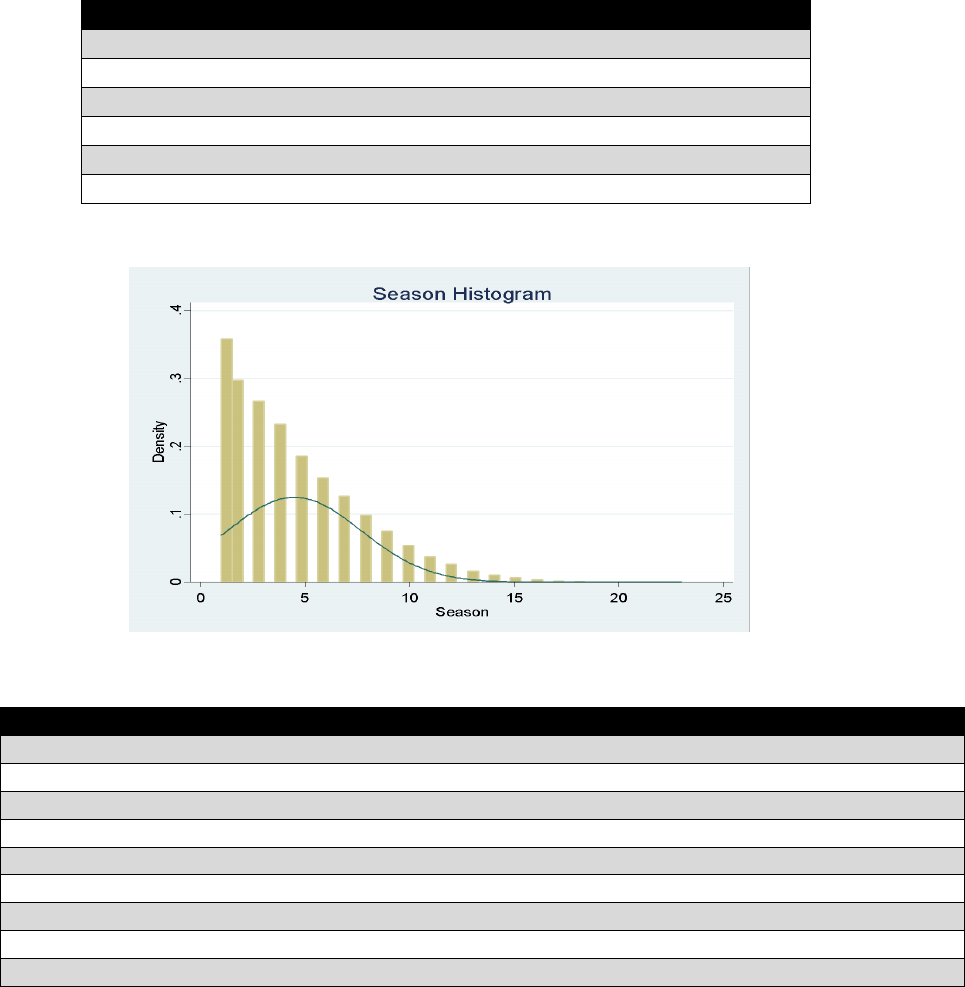
31
Appendix
Table 1
Variable(
Obs(
Mean(
Std.(Dev.(
Min(
Max(
Age$
19,868$
26.5154$
3.328497$
21$
46$
Games$Played$
19,583$
10.59097$
5.597082$
1$
16$
Games$Started$
19,551$
5.25968$
6.079695$
0$
18$
Weight$
19,990$
242.9355$
44.97969$
150$
376$
Height$
19,751$
74.02314$
2.555594$
65$
81$
Season$
19,995$
4.493723$
3.202448$
1$
23$
Diagram 1
Table 2
Round(
DB(
DL(
K(
LB(
LS(
OL(
P(
QB(
RB(
TE(
Total(
1$
525$
561$
10$
410$
0$
464$
0$
258$
211$
121$
2,876$
2$
509$
354$
18$
364$
0$
365$
0$
99$
156$
134$
2,297$
3$
382$
373$
11$
304$
0$
365$
20$
95$
137$
169$
2,177$
4$
403$
301$
19$
313$
0$
325$
22$
61$
209$
136$
2,002$
5$
365$
257$
26$
245$
3$
244$
54$
41$
154$
125$
1,625$
6$
287$
219$
51$
182$
0$
234$
44$
74$
167$
121$
1,503$
7$
273$
225$
29$
238$
0$
220$
36$
57$
152$
108$
1,487$
Undrafted$
1,076$
772$
260$
936$
62$
742$
183$
149$
737$
367$
5,883$
Total$
3,820$
3,062$
424$
2,992$
65$
2,959$
359$
834$
1,923$
1,281$
19,850$

32
Appendix
Table 3
Round(
In(
Exit(
Total(
Exit(
Percentage(
1$
2,307$
569$
2,876$
20%$
2$
1,884$
414$
2,298$
18%$
3$
1,772$
406$
2,178$
19%$
4$
1,606$
408$
2,014$
20%$
5$
1,291$
342$
1,633$
21%$
6$
1,187$
323$
1,510$
21%$
7$
1,122$
384$
1,506$
25%$
Undrafted$
4,360$
1,614$
5,974$
27%$
Total$
15,529$
4,460$
19,989$
22%$
Table 4
Year(
In(
Exit(
Total(
Exit(Percentage(
2008$
1,495$
400$
1,895$
21%$
2009$
1,546$
414$
1,960$
21%$
2010$
1,573$
443$
2,016$
22%$
2011$
1,540$
447$
1,987$
22%$
2012$
1,530$
488$
2,018$
24%$
2013$
1,543$
471$
2,014$
23%$
2014$
1,533$
514$
2,047$
25%$
2015$
1,460$
591$
2,051$
29%$
2016$
1,349$
686$
2,035$
34%$
2017$
1,943$
0$
1,943$
0%$
Total$
15,512$
4,454$
19,966$
22%$

33
Appendix
Table 5
Team(
In(
Exit(
Total(
Exit(
Percentage(
Arizona$Cardinals$
459$
136$
595$
23%$
Atlanta$Falcons$
444$
137$
581$
24%$
Baltimore$Ravens$
499$
126$
625$
20%$
Buffalo$Bills$
504$
138$
642$
21%$
Carolina$Panthers$
488$
141$
629$
22%$
Chicago$Bears$
465$
167$
632$
26%$
Cincinatti$Bengals$
513$
100$
613$
16%$
Cleveland$Browns$
484$
151$
635$
24%$
Dallas$Cowboys$
497$
123$
620$
20%$
Denver$Broncos$
462$
133$
595$
22%$
Detriot$Lions$
475$
182$
657$
28%$
Green$Bay$Packers$
506$
100$
606$
17%$
Houston$Texans$
493$
131$
624$
21%$
Indiana p o lis $C o lts$
510$
171$
681$
25%$
Jacksonville$Jagu a rs$
512$
160$
672$
24%$
Kansas$City$Chiefs$
472$
142$
614$
23%$
LA$Chargers$
498$
147$
645$
23%$
LA$Rams$
489$
135$
624$
22%$
Miami$Dolphins$
499$
149$
648$
23%$
Minnesota$Vikings$
465$
111$
576$
19%$
New$England$
Patriots$
531$
120$
651$
18%$
New$Orleans$Saints$
470$
166$
636$
26%$
New$York$Giants$
467$
159$
626$
25%$
New$York$Jets$
485$
137$
622$
22%$
Oakland$Raiders$
467$
147$
614$
24%$
Philadelphia$Eagles$
480$
114$
594$
19%$
Pittsburgh$Steelers$
465$
125$
590$
21%$
San$Francisco$49ers$
479$
126$
605$
21%$
Seattle$Seahawks$
516$
130$
646$
20%$
Tampa$Bay$
Buccaneers$
497$
155$
652$
24%$
Tennesse$Titans$
464$
142$
606$
23%$
Washington$
Redskins$
474$
159$
633$
25%$
Total$
15,529$
4,460$
19,989$
22%$

34
Appendix
Table 6
VARIABLES
Model 1
Model 2
Model 3
(Base)
(UDFA)
(Seventh)
Undrafted Free Agent
0.300***
(0.0339)
Age
0.0853***
0.0894***
0.126***
(0.0041)
(0.0131)
(0.0124)
Wt
0.0001
0.0002
0.0000
(0.0005)
(0.0005)
(0.0005)
Height
-0.0255***
-0.0284***
-0.0319***
(0.0082)
(0.0082)
(0.0082)
Year
(0.0055)
(0.0042)
(0.0010)
(0.0053)
(0.0053)
(0.0053)
2.Season
-0.384***
-0.434***
(0.0594)
(0.0591)
3.Season
-0.304***
-0.394***
(0.0629)
(0.0620)
4.Season
-0.318***
-0.450***
(0.0707)
(0.0689)
5.Season
-0.430***
-0.606***
(0.0823)
(0.0796)
6.Season
-0.422***
-0.639***
(0.0930)
(0.0894)
7.Season
-0.307***
-0.563***
(0.1030)
(0.0986)
8.Season
-0.324***
-0.616***
(0.1160)
(0.1100)
9.Season
(0.1100)
-0.440***
(0.1270)
(0.1200)
10.Season
(0.1930)
-0.561***
(0.1430)
(0.1360)
11.Season
(0.1870)
-0.584***
(0.1590)
(0.1520)
12.Season
(0.1580)
-0.588***
(0.1770)
(0.1690)
13.Season
(0.2630)
-0.720***
(0.2010)
(0.1930)
14.Season
(0.3270)
-0.800***
(0.2290)
(0.2210)
15.Season
(0.3310)
-0.843***

35
(0.2620)
(0.2540)
16.Season
(0.2240)
-0.783***
(0.3050)
(0.2960)
17.Season
0.0133
-0.595*
(0.3610)
(0.3530)
18.Season
-1.227**
-1.873***
(0.6220)
(0.6170)
19.Season
(1.0990)
-1.746**
(0.7520)
(0.7460)
20.Season
(0.9970)
-1.693**
(0.7530)
(0.7480)
21.Season
(0.2030)
(0.8330)
(0.6130)
(0.6100)
22.Season
-1.761*
-2.374**
(1.0450)
(1.0410)
23o.Season
-
-
Atlanta Falcons
0.0378
0.0207
(0.1220)
(0.1220)
Baltimore Ravens
(0.0861)
(0.0943)
(0.1250)
(0.1250)
Buffalo Bills
(0.0792)
(0.0696)
(0.1230)
(0.1230)
Carolina Panthers
0.0390
0.0566
(0.1210)
(0.1210)
Chicago Bears
0.220*
0.211*
(0.1170)
(0.1160)
Cincinatti Bengals
-0.257*
-0.288**
(0.1330)
(0.1330)
Cleveland Browns
0.1110
0.1200
(0.1210)
(0.1210)
Dallas Cowboys
(0.0667)
(0.0569)
(0.1260)
(0.1260)
Denver Broncos
0.0391
0.0304
(0.1230)
(0.1230)
Detriot Lions
0.278**
0.275**
(0.1150)
(0.1140)
Green Bay Packers
-0.255*
-0.253*
(0.1330)
(0.1330)
Houston Texans
(0.0214)
(0.0375)
(0.1240)
(0.1240)
Indianapolis Colts
0.1360
0.1460
(0.1160)
(0.1160)

36
Jacksonville Jaguars
0.1600
0.1550
(0.1180)
(0.1180)
Kansas City Chiefs
0.1190
0.1240
(0.1210)
(0.1210)
LA Chargers
0.0202
0.0434
(0.1200)
(0.1200)
LA Rams
0.0488
0.0470
(0.1230)
(0.1230)
Miami Dolphins
0.0328
0.0288
(0.1210)
(0.1210)
Minnesota Vikings
(0.1060)
(0.1140)
(0.1290)
(0.1290)
New England Patriots
(0.1770)
(0.1610)
(0.1260)
(0.1260)
New Orleans Saints
0.1500
0.1670
(0.1170)
(0.1170)
New York Giants
0.217*
0.208*
(0.1180)
(0.1180)
New York Jets
(0.0011)
0.0051
(0.1220)
(0.1220)
Oakland Raiders
0.1300
0.1170
(0.1200)
(0.1200)
Philadelphia Eagles
(0.1360)
(0.1430)
(0.1280)
(0.1280)
Pittsburgh Steelers
(0.0828)
(0.0700)
(0.1250)
(0.1250)
San Francisco 49ers
(0.0451)
(0.0456)
(0.1250)
(0.1250)
Seattle Seahawks
(0.0661)
(0.0513)
(0.1240)
(0.1240)
Tampa Bay Buccaneers
0.1330
0.1530
(0.1190)
(0.1190)
Tennesse Titans
0.1010
0.0751
(0.1210)
(0.1210)
Washington Redskins
0.1310
0.1280
(0.1180)
(0.1180)
Round 2
(0.0652)
(0.0651)
Round 3
0.0089
(0.0654)
Round 4
0.0850
(0.0655)
Round 5
0.148**
(0.0691)

37
Round 6
0.148**
(0.0704)
Round 7
0.362***
(0.0670)
Undrafted
0.395***
(0.0494)
Seventh Round
0.191***
(0.0544)
Constant
9.1230
6.8980
0.0255
(10.6200)
(10.6900)
(10.6700)
Observations
19698
19697
19697
Standard errors in
parentheses
*** p<0.01, ** p<0.05,
* p<0.1
Diagram 2
0.00 0.25 0.50 0.75 1.00
Probability of Survival
0 5 10 15 20 25
Season
Round = 1 Round = 2
Round = 3 Round = 4
Round = 5 Round = 6
Round = 7 Undrafted
Kaplan-Meier survival estimates
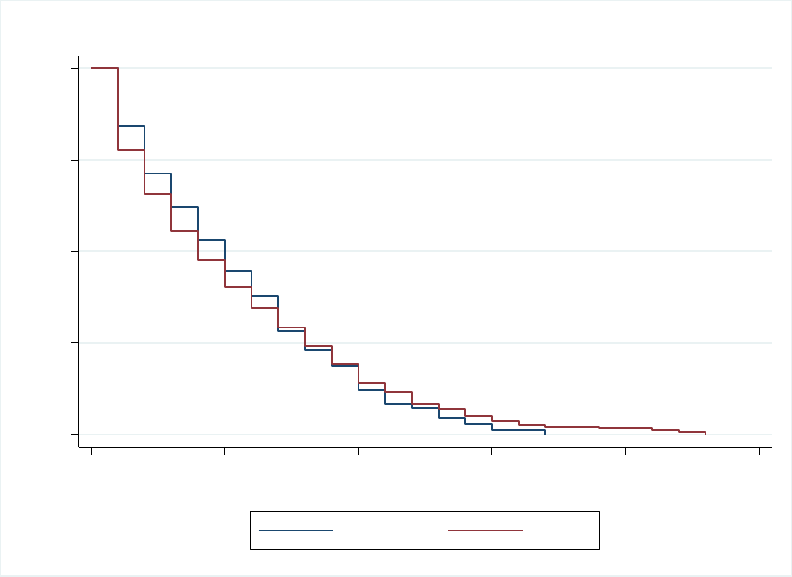
38
Appendix
Diagram 3
0.00 0.25 0.50 0.75 1.00
Probability of Survival
0 5 10 15 20 25
Season
Seventh UDFA
Kaplan-Meier survival estimates
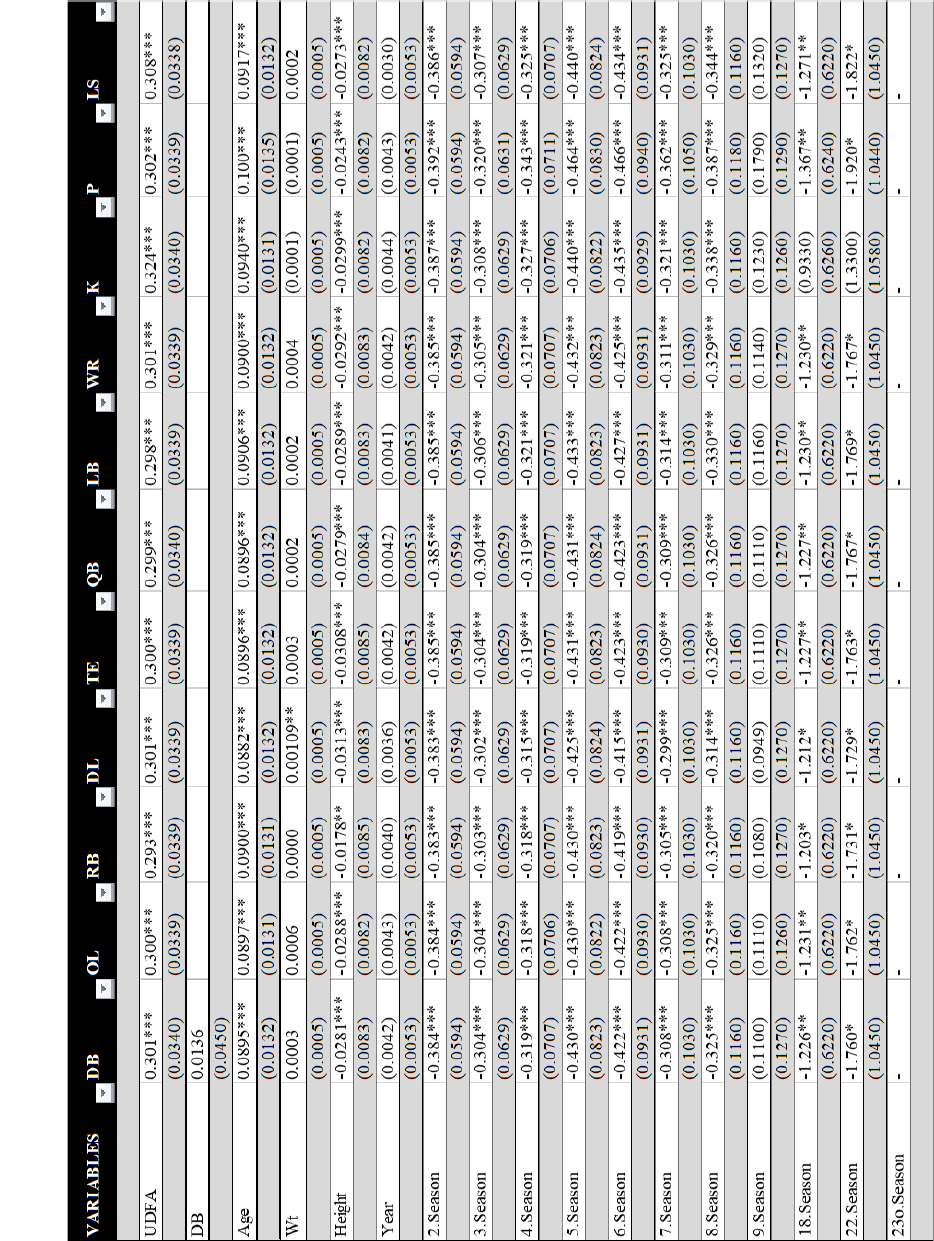
39
Appendix
Table 7
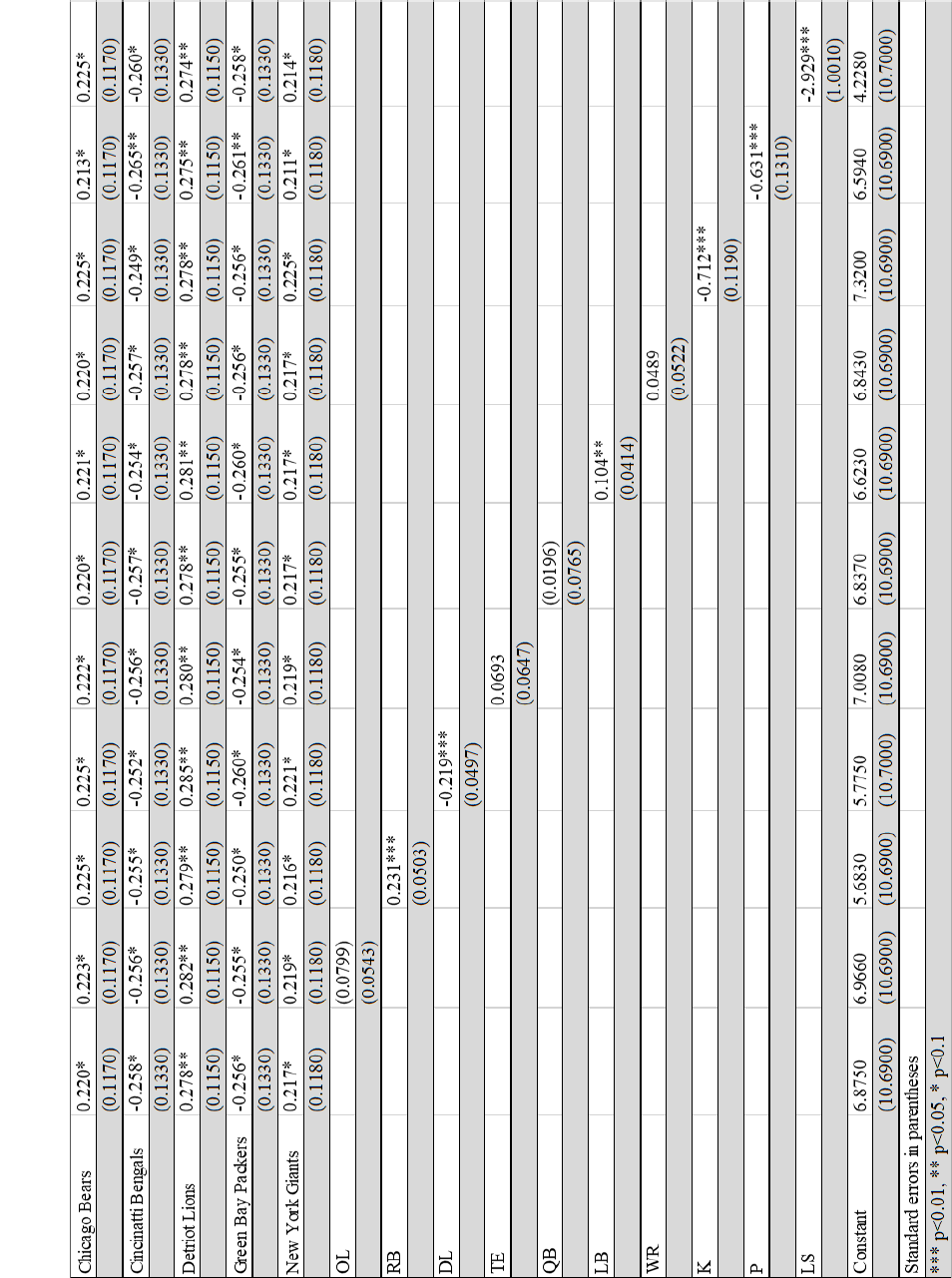
40
Appendix
Table 7
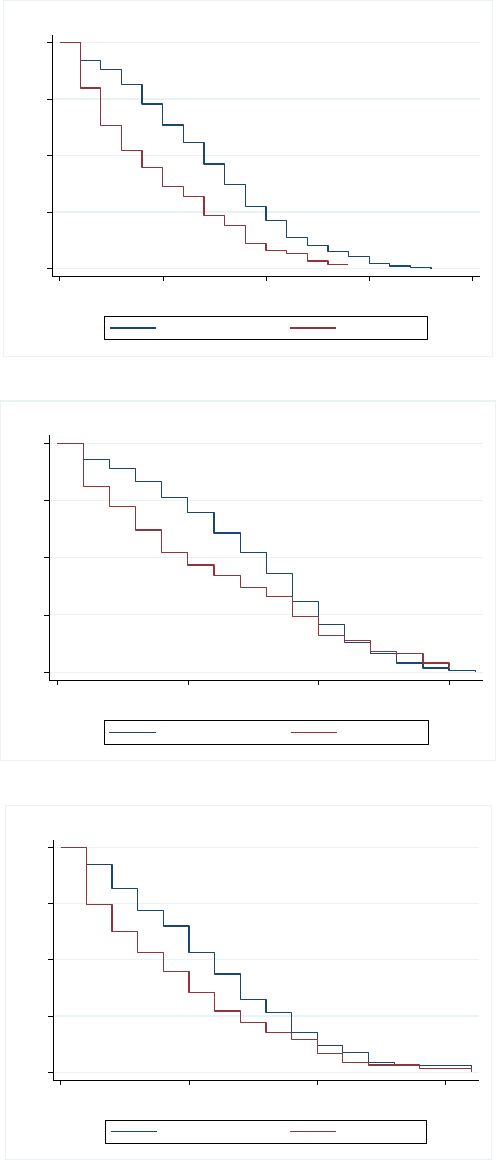
41
Appendix
Diagram 4
Diagram 5
Diagram 6
0.00 0.25 0.50 0.75 1.00
Probability of Survival
0 5 10 15 20
Season
Seventh Round DB Undrafted DB
Kaplan-Meier survival estimates
0.00 0.25 0.50 0.75 1.00
Probability of Survival
0 5 10 15
Season
Seventh Round OL Undrafted OL
Kaplan-Meier survival estimates
0.00 0.25 0.50 0.75 1.00
Probability of Survival
0 5 10 15
Season
Seventh Round RB Undrafted RB
Kaplan-Meier survival estimates

42
Appendix
Diagram 7
Diagram 8
Diagram 9
0.00 0.25 0.50 0.75 1.00
Probability of Survival
0 5 10 15 20
Season
Seventh Round DL Undrafted DL
Kaplan-Meier survival estimates
0.00 0.25 0.50 0.75 1.00
Probability of Survival
0 5 10 15 20
Season
Seventh Round TE Undrafted TE
Kaplan-Meier survival estimates
0.00 0.25 0.50 0.75 1.00
Probability of Survival
0 5 10 15 20
Season
Seventh Round QB Undrafted QB
Kaplan-Meier survival estimates
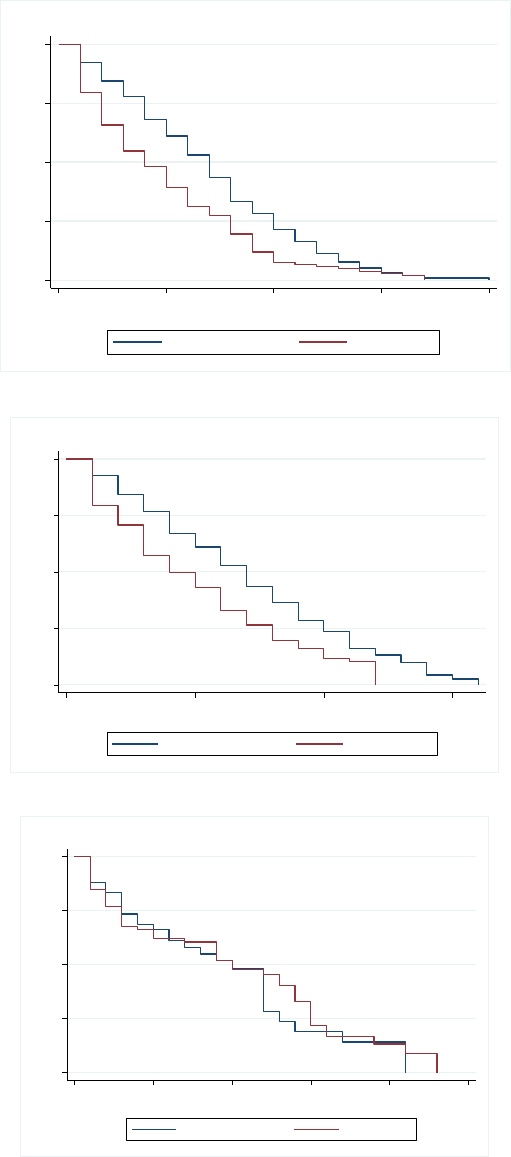
43
Appendix
Diagram 10
Diagram 11
Diagram 12
0.00 0.25 0.50 0.75 1.00
Probability of Survival
0 5 10 15 20
Season
Seventh Round LB Undrafted LB
Kaplan-Meier survival estimates
0.00 0.25 0.50 0.75 1.00
Probability of Survival
0 5 10 15
Season
Seventh Round WR Undrafted WR
Kaplan-Meier survival estimates
0.00 0.25 0.50 0.75 1.00
Probability of Survival
0 5 10 15 20 25
Season
Seventh Round K Undrafted K
Kaplan-Meier survival estimates
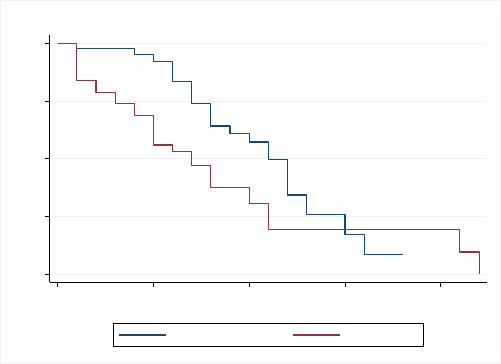
44
Appendix
Diagram 13
0.00 0.25 0.50 0.75 1.00
Probability of Survival
0 5 10 15 20
Season
Seventh Round P Undrafted P
Kaplan-Meier survival estimates

45
Bibliography
Atkinson, Scott E., Linda R. Stanley, and John Tschirhart. "Revenue Sharing as an
Incentive in an Agency Problem: An Example from the National Football
League." The RAND Journal of Economics 19, no. 1 (1988): 27-43.
http://www.jstor.org/stable/2555395.
Benne, Jon. "Everything you need to know about NFL undrafted free agency."
SBNation.com. April 28, 2017. Accessed November 14, 2017.
https://www.sbnation.com/nfl/2017/4/28/15227862/undrafted-free-agents-nfl-
2017-how-it-works
Bishop, Greg, and Andy Benoit. 2016. "UNPACKING”ANGRY DOUG BALDWIN."
Sports Illustrated 125, no. 5: 22-28. Academic Search Premier, EBSCOhost
(accessed October 9, 2017).
Boal, William M., and Michael R Ransom. "Monopsony in the Labor Market." Journal of
Economic Literature 35, no. 1 (1997): 86-112.
http://www.jstor.org/stable/2729694.
Hendricks, W., DeBrock, L. & Koenker, R. (2003). Uncertainty, Hiring and Subsequent
Performance: The NFL Draft. Journal of Labor Economics, 21(4), 857-886.
Hope, Dan. "How an Undrafted Free Agent Becomes an NFL Star." Bleacher Report.
April 11, 2017. Accessed November 14, 2017.
http://bleacherreport.com/articles/1710889-how-an-undrafted-free-agent-
becomes-an-nfl-star.
Howe, Jeff. "Wes Welker Has Spent Football Life Proving Doubters Wrong, From
College Coaches to NFL Executives." NESN. January 3, 2012. Accessed
November 14, 2017. https://nesn.com/2012/01/wes-welker-has-spent-football-
life-proving-doubters-wrong-from-college-coaches-to-nfl-executives/.
J.D. Matsudaira, Monopsony in Health Labor Markets, In Encyclopedia of Health
Economics, edited by Anthony J. Culyer,, Elsevier, San Diego, 2014, Pages 325-
333, ISBN 9780123756794, https://doi.org/10.1016/B978-0-12-375678-7.01109-
3.
(https://www.sciencedirect.com/science/article/pii/B9780123756787011093)

46
Bibliography
Ginnitti, Michael. "NFL Minimum Salaries for 2017." The Daily Spot. January 28, 2017.
Accessed November 14, 2017. https://www.spotrac.com/blog/nfl-minimum-
salaries-for-2017/.
G., Gary. "Kurt Warner: A True Underdog Story." Bleacher Report. April 12, 2017.
Accessed November 14, 2017. http://bleacherreport.com/articles/168590-
stocking-shelves-to-winning-a-ring-a-true-underdog-story.
Kitchens, Carl T. "Are Winners Promoted Too Often? Evidence from the NFL Draft
1999-2012." Economic Inquiry 53, no. 2 (April 2015): 1317-1330.
Layden, Tim. "Silver Star." Sports Illustrated 105, no. 23 (December 11, 2006): 66-74.
Academic Search Premier, EBSCOhost (accessed October 9, 2017)
Lillibridge, Marc. "The Anatomy of a 53-Man Roster in the NFL." Bleacher Report.
April 12, 2017. Accessed November 14, 2017.
http://bleacherreport.com/articles/1640782-the-anatomy-of-a-53-man-roster-in-
the-nfl.
Massey, C. and Thaler, R. (2005). Overconfidence vs. Market Efficiency in the National
Football League, NBER Working Paper No. 11270.
Pyle, Benjamin D., "The Law and Economics of Monopsony in the NFL: An Analysis of
the NFL Rookie Draft and Countervailing Force" (2013). CMC Senior Theses.
612. http://scholarship.claremont.edu/cmc_theses/612.
Riddle, Ryan. "The Hidden Advantage of Being a High NFL Draft Pick." Bleacher
Report. April 12, 2017. Accessed November 14, 2017.
http://bleacherreport.com/articles/2431195-the-hidden-advantage-of-being-a-
high-nfl-draft-pick.
Schultz, Jordan. "We Pick The 20 Breakout Stars Of The 2016 NFL Season." The
Huffington Post. August 30, 2016. Accessed November 17, 2017.
https://www.huffingtonpost.com/entry/20-breakout-stars-of-2016-
nfl_us_57bc7403e4b0b51733a5ecdc.
Scully, Gerald W. "Pay and Performance in Major League Baseball." The American
Economic Review 64, no. 6 (1974): 915-30. http://www.jstor.org/stable/1815242.

47
Bibliography
Stapleton, Arnie. "It's quite frequently better to go undrafted in the NFL."
DeseretNews.com. April 23, 2013. Accessed November 14, 2017.
https://www.deseretnews.com/article/765627813/Sometimes-its-best-to-go-
undrafted-in-the-NFL.html.
Sports Reference. "Pro Football Reference." Advertisement. Football Stats and History
The complete source for current and historical NFL, AFL, and AAFC players,
teams, scores and leaders. Accessed November 14, 2017. https://www.pro-
football-reference.com/.
Tavis Barr, Udayan Roy, The effect of labor market monopsony on economic growth, In
Journal of Macroeconomics, Volume 30, Issue 4, 2008, Pages 1446-1467, ISSN
0164-0704,
https://doi.org/10.1016/j.jmacro.2008.05.001.(http://www.sciencedirect.com/scien
ce/article/pii/S0164070408000360).
